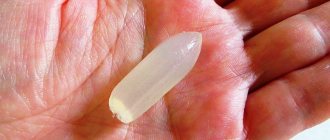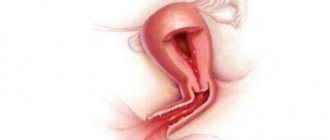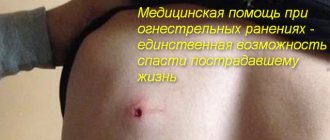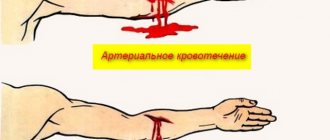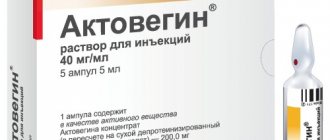Four main types of bleeding
Depending on the source, the following main types of bleeding are distinguished:
- Bleeding from the arteries is very dangerous because a significant amount of blood is lost quickly. At the same time, the blood is scarlet and flows in the form of a pulsating fountain.
- Bleeding from the veins is also dangerous if the victim is not given prompt assistance. This is indicated by the appearance of dark blood slowly flowing from the injured vessel.
- Capillary blood loss often does not pose a serious danger. It is observed more often with minor superficial damage to the skin.
- Internal (parenchymal) - with it, blood flows into the cavities of the human body. It is very dangerous if not recognized in time. It is more often observed with damage to internal organs, including parenchymal ones. Since blood does not leak out, it can be determined mainly by such signs as rapid breathing, fainting, and paleness.
Stop bleeding on the head and neck
Damage to the blood vessels of the head has its own characteristics. The fact is that the process of stopping bleeding is significantly accelerated by contracting the injured vessel and reducing its lumen. This physiological phenomenon facilitates the formation of a blood clot and sealing of arteries, veins, and capillaries. The vessels of the head are fixed in the subcutaneous tissue by connective tissue bridges that prevent their contraction. The consequence of this is prolonged and massive bleeding, even with minor injuries to the scalp. Difficulties in applying bandages to this area lie in the inconvenience of fixing the bandage, its constant slipping and unwinding.
Applying a Hippocratic cap bandage
For head injuries, especially the parietal region, various types of bandages are proposed. The most commonly used bandage dressings are the “Hippocratic cap” and “bonnet”. The first is less secure against slipping, but can be performed by one person. For a “bonnet” type bandage, an assistant is needed, which can be the victim himself in case of a minor injury.
Applying a cap type bandage
When applying a tourniquet or pressure bandage to the neck area, it is necessary to maintain the patency of the airways and blood flow through intact vessels. For this purpose, on the uninjured side of the neck, the role of a protector will be played by the victim’s hand, thrown up.
You can also use a board, stick, or wire splint, after wrapping them in cloth or bandage. If the wound is located in the lower part of the neck, a tourniquet or bandage can be thrown across the axillary region of the opposite side.
In case of applying a tourniquet or twisting, after stopping the bleeding, treat the wound with a solution of hydrogen peroxide or chlorhexidine. The edges of the wound are lubricated with solutions of betadine, iodine, and brilliant green. Apply an aseptic bandage. In the cold season, they wrap the injured limb. When transporting to a medical facility or while waiting for an ambulance, you can give the victim water or sweet tea. It is forbidden to give any drink or food if bleeding from internal organs or impaired consciousness is suspected. In case of massive or prolonged bleeding, the victim should be in a horizontal position (lying down). If there are signs of low blood pressure (weakness, dizziness, nausea, pale and moist skin), it is necessary to raise your legs higher than your body, and, on the contrary, do not put anything under your head.
medlibera.ru
First aid for arterial bleeding
The damaged artery must be immediately pressed against the adjacent bone to temporarily stop the bleeding.
Methods of pressing arteries:
- Carotid artery – press your palm to the back of the victim’s neck and press the fingers of the other hand on the artery.
- The brachial artery is easily accessible and must be pressed against the humerus.
- It is quite difficult to stop bleeding from the subclavian artery. To do this, you need to take the victim’s hand back and press the artery located behind the collarbone to the first rib.
- You have to press hard on the axillary artery with your fingers to squeeze it, because it is located quite deep.
- The femoral artery is very large and must be pressed against the femur with a fist. If this is not done, the victim may die within 2-3 minutes.
- The popliteal artery must be pressed into the knee fossa, which does not require much effort.
The location of some arteries on the human body and where they stop
Areas on the human body that supply arteries and places where they need to be clamped during bleeding
First aid for bleeding from the arteries of the extremities is performed by compressing them, strongly bending the limb and applying a tourniquet. If you cannot squeeze the vessel of the limb with your fingers, you need to bend the limb as much as possible, after first placing a thick gauze roller on the inside of the joint.
If the blood continues to flow, a tourniquet must be applied. It must be provided quickly, since the blood flows out very intensely.
The tourniquet can be held for up to half an hour in winter and up to an hour in summer. If the doctor does not arrive within the specified period of time, you must slowly remove the tourniquet and wait until blood circulation is restored. After that, apply it again. In this case, the pulse on the injured limb should not be palpable. Then the bleeding will stop.
We must remember that if used incorrectly, a tourniquet poses a greater danger than the bleeding itself.
If there is no special tourniquet, it can be replaced with materials such as a towel, belt, bandage. They are twisted with a stick and secured to prevent unwinding. Shoelaces, thin rope and similar materials must not be used.
Application [ edit | edit code ]
A tourniquet is a means of temporarily stopping bleeding from the great vessels of the extremities. Applying a tourniquet is one of the first aid measures [2]. A timely tourniquet can save the victim's life.
The tourniquet is applied above the wound, since it is used only for arterial bleeding
, or if the victim with any severe bleeding is in an area of immediate danger. In this case, the type of bleeding is determined immediately after its evacuation in a relatively safe area and the tourniquet is either removed, if the artery is not affected, or left. The time elapsed from the moment the tourniquet was applied should not exceed an hour in the summer and half an hour in the winter. Formally, when applying a tourniquet, a note should be placed under it indicating the time of application. In reality, due to problems with drawing up (searching for paper and pens in field or combat conditions, while there are more pressing tasks of saving the life of the victim) and preserving (the paper gets soaked in blood and spreads or is simply lost) notes, in modern In practice, it is customary to write the time of application of the tourniquet with a marker directly on the victim’s forehead. If the tourniquet is left on the limb for more than 2 hours, tissue death is possible due to oxygen starvation. In an unfavorable case, this will lead to amputation of the limb.
Assisting with bleeding from a vein
Such blood loss occurs with deep injuries. First aid for venous bleeding is carried out immediately. Injured veins can suck in air because the pressure in them is lower than atmospheric pressure. In this case, air bubbles can clog blood vessels in various organs, which can lead to the death of the victim.
When providing assistance, the wound should not be washed or cleaned of dirt and blood clots. You need to do the following:
- Use a damp cloth to clean the skin in the direction away from the wound;
- cover deep damage with a sterile swab;
- then cover the wound surface with several layers of sterile bandage;
- place an unrolled bandage on it to provide pressure;
- this bandage must be bandaged very tightly;
- if blood leaks through the bandage, place napkins on top and bandage them tightly;
- raise the limb and leave it in this position.
In order to apply a bandage correctly, you need to:
- When bandaging your hand, you need to bend it.
- If a leg is bandaged, it must also be bent at the knee.
- When applying a bandage, cover half of its previous turn.
- The position of the bandaged limb must be left the same as it was before bandaging.
Bandage for venous bleeding
Flexing the limb at the joint to stop bleeding
Stopping bleeding can be achieved by maximal flexion of the limb in the joint located above the wound. To enhance the compression of the vessels, a cushion (bandage, bundle of clothing, etc.) is placed at the bend.
If the arteries of the hand and forearm are damaged (Fig. D), the arm is bent at the elbow joint and secured with a bandage or improvised material (belt, scarf, etc.). When the brachial, axillary and subclavian arteries and veins are injured, the arm on the affected side is brought as far as possible behind the back with flexion at the elbow. Another option to stop bleeding in this area is to place both hands behind your back with your elbows bent (Fig. A). However, this method compresses the arteries and veins on both sides, which disrupts blood flow in a healthy limb. By bending the leg at the hip and knee joint, blood loss from the popliteal artery, arteries of the leg and foot is achieved (Fig. B and C).
First aid for capillary bleeding
It often stops on its own. Characteristic is the slow leakage of blood from the entire wound surface. However, there are also serious injuries accompanied by significant blood loss. The greatest danger is caused by internal capillary bleeding.
The main causes of bleeding from capillaries:
- Blood diseases accompanied by impaired blood clotting.
- Various traumatic injuries.
- Vascular diseases (tumors, purulent inflammation of the skin affecting capillaries).
- Common diseases affecting the walls of blood vessels such as neoplasms, atherosclerosis, rheumatoid arthritis.
- Hormonal disorders.
More often, capillary bleeding does not cause large blood loss; its danger lies in infection with pathogenic microbes.
When providing medical care for bleeding from the capillaries of the extremities, the following actions must be taken:
- Elevate the injured limb above the heart area, which helps reduce blood loss.
- For minor injuries, it is necessary to treat the skin around the wound with antiseptics. Cover the top with a bactericidal plaster.
- If there is a lot of bleeding, you need to apply a pressure bandage.
- If there is very strong bleeding, it is necessary to bend the limb as much as possible over the wound. If this does not help, apply a tourniquet.
- Apply cold to the wound, which will help stop blood loss and reduce pain.
When bleeding from numerous capillaries of the nose, which is quite common, you also need to be able to provide assistance. The reason for this may be the weakening of the vascular wall due to colds. It can also be contributed by a hypertensive crisis, traumatic injuries to the nose and other negative factors. First you need to calm the patient down, because when a person is worried, his heart beats faster, which contributes to increased bleeding.
Steps to help with nosebleeds:
- It is necessary to press the wings of the nose with your fingers, this helps to compress the bleeding vessels and stop the bleeding. The patient's head should be tilted slightly forward and not thrown back, since this will make it impossible to control the intensity of blood loss.
- Apply ice or a cold object to the bridge of the nose so that the blood vessels narrow under the influence of cold. This will help reduce bleeding.
- If the bleeding continues, folded pieces of bandage, previously soaked in 3% hydrogen peroxide, should be inserted into the nasal passages. Leave the ends of these tampons outside and secure with a bandage.
- Six hours after the bleeding has stopped, remove the tampons very carefully, after moistening their tips, being careful not to tear off the formed blood clot.
- To stop the bleeding faster, the patient must be given a medicine that strengthens the walls of blood vessels - calcium preparations, Ascorutin, Rutin.
- If blood loss continues, the patient must be given a hemostatic medicine (Ditsinon, Vikasol), and urgently contact an otolaryngologist or call emergency help.
Correct head position to stop nosebleeds
Tourniquet technique
The algorithm for dealing with bleeding is as follows:
- Determine the type of bleeding.
- Press over the wound with your hand.
- Apply a tourniquet, but “extra” hands will not hurt, especially if the bleeding is severe.
- Apply a sterile bandage to the wound.
- Write a note indicating the time of application of the tourniquet and attach it, slipping it under the tourniquet.
- Urgently transport the victim to the hospital, it is better to call an ambulance.
When applying a tourniquet, the type of bleeding should be taken into account: if arterial, apply above the wound, if venous, apply below, at a distance of 6-10 cm from the wound. It is also necessary to know the anatomical areas where arteries can be clamped:
- upper third of the thigh;
- upper and middle third of the shoulder;
- neck.
In these areas, the artery runs close to the bone and can be compressed. On the lower leg and forearm, the arteries go deep, in the interosseous space; applying a tourniquet does not make sense.
A tourniquet is applied to the neck if the carotid artery is damaged. This requires quick action because the blood loss is very large. The neck cannot be wrapped in a tourniquet like a limb, so a hard object is placed on the healthy side of the neck, most often this is the victim’s raised hand. The artery must be pressed to the spine below the site of injury, a bandage should be applied and a tourniquet on top, secured to the healthy side.
The skin under the tourniquet must be wrapped in cloth. In the absence of a tourniquet, you can use a belt, a thick cord, a rope, or a strip of thick fabric, tightening them with a twist on the undamaged side. In case of arterial bleeding, the twist is applied above the wound, in case of venous bleeding - below. It is also necessary to protect the tourniquet from stretching and relaxing by securing it well.
The maximum time for applying the tourniquet should be observed in summer and winter.
For arterial bleeding in cold weather, continuous compression with a tourniquet should not exceed 1.5 hours, in warm weather - 2 hours. It is necessary to loosen the tourniquet every 30-40 minutes, after pressing the bleeding vessel with your hand.
Venous tourniquets are applied for a maximum of 6 hours.
The technique for applying venous tourniquets is different; the compression force should be less, but sufficient to stop bleeding, while maintaining pulsation of the arteries below the wound.
How to apply a tourniquet correctly?
When applying a tourniquet, first put rubber gloves on your hands. Then the limb affected by the injury is raised and examined. The tourniquet is not applied to the naked body, but over a fabric pad. This could be a person’s clothing, a towel, a bandage, or cotton wool. A medical tourniquet applied in this way will not cross and will not pinch the skin.
You need to take its end in one hand and the middle in the other. Then stretch it harder, and only then circle it around your arms or legs. With each subsequent turn of the winding, the harness stretches less. The loose ends are tied with a knot or secured with a hook and chain. A note must be placed under any one turn of the tape indicating the time it was applied.
The hemostatic tourniquet should not be left in place for more than two hours, otherwise paralysis or necrosis of the arm or leg may occur. Every hour in the warm season and half an hour in winter, the tourniquet is relaxed for a few minutes (at this time the vessel is pressed with your fingers), the application of the tourniquet during bleeding is done in the same way as the first time, only a little higher.
If the tourniquet is applied incorrectly. Their veins could have been accidentally pulled. This will cause the pressure in the blood vessels to increase and bleeding to increase. If the tourniquet is too tight, muscles, nerves, and tissues can be damaged, which leads to paralysis of the limbs. The victim with a tourniquet applied is transported to a medical facility first.
The tourniquet can be applied using a plywood splint. It is placed on the opposite side of the damaged vessel. This method has a gentle effect. If the upper third of the thigh or shoulder is injured, a medical tourniquet is applied in a figure eight when there is bleeding.
A tourniquet is applied to damaged neck vessels using a wooden strip or splint in the form of a ladder. These devices are placed on the side opposite the wound. Due to the splint, the trachea will not be compressed and if there is no splint at hand, you need to put your hand on the back of your head, it will act as a splint. The hemostatic tourniquet can be replaced with a twist, using available material for this: handkerchiefs, scarves, belts, ties.
Types of blood loss
First aid for bleeding should take into account the type of damaged vessels, as well as the location of the damage.
There are several types of blood loss.
So, according to the type of damaged vessel, several forms are distinguished, each of which has its own symptoms:
- Capillary. When multiple, very small vessels are affected, there is a slight loss of blood slowly oozing from the damaged area.
- Venous. The blood is dark in color, flows intensively from the site of injury, and can coagulate. The victim's clothes get wet quite quickly. Damage to the veins in the neck area is very dangerous.
- Arterial. It is difficult to confuse this type of bleeding: bright scarlet blood flows out of the wound, pulsating, at high speed. The victim's skin turns pale, his lips turn blue, and he feels very weak.
- Mixed. A dangerous form that occurs with extensive damage, usually after car accidents. All vessels are adjacent to each other, so their simultaneous damage is possible.
With arterial and venous bleeding, there is a serious risk to human life, so first aid must be provided in a timely manner.
No less important is the division of blood loss according to internal and external characteristics. There is external and internal bleeding.
With external blood loss, blood is released from the wound. Internal bleeding is determined by a number of signs, which we will discuss later. This is a very dangerous type of injury, because if it is not recognized in time, the victim will die.
In addition, there is a division of blood loss according to the time of its occurrence. Thus, there are primary bleeding, which begins at the time of injury, and secondary bleeding, which appears after a few days.
Types of bleeding and first aid for them are closely interrelated. Therefore, you need to know how to provide assistance in each specific case.
